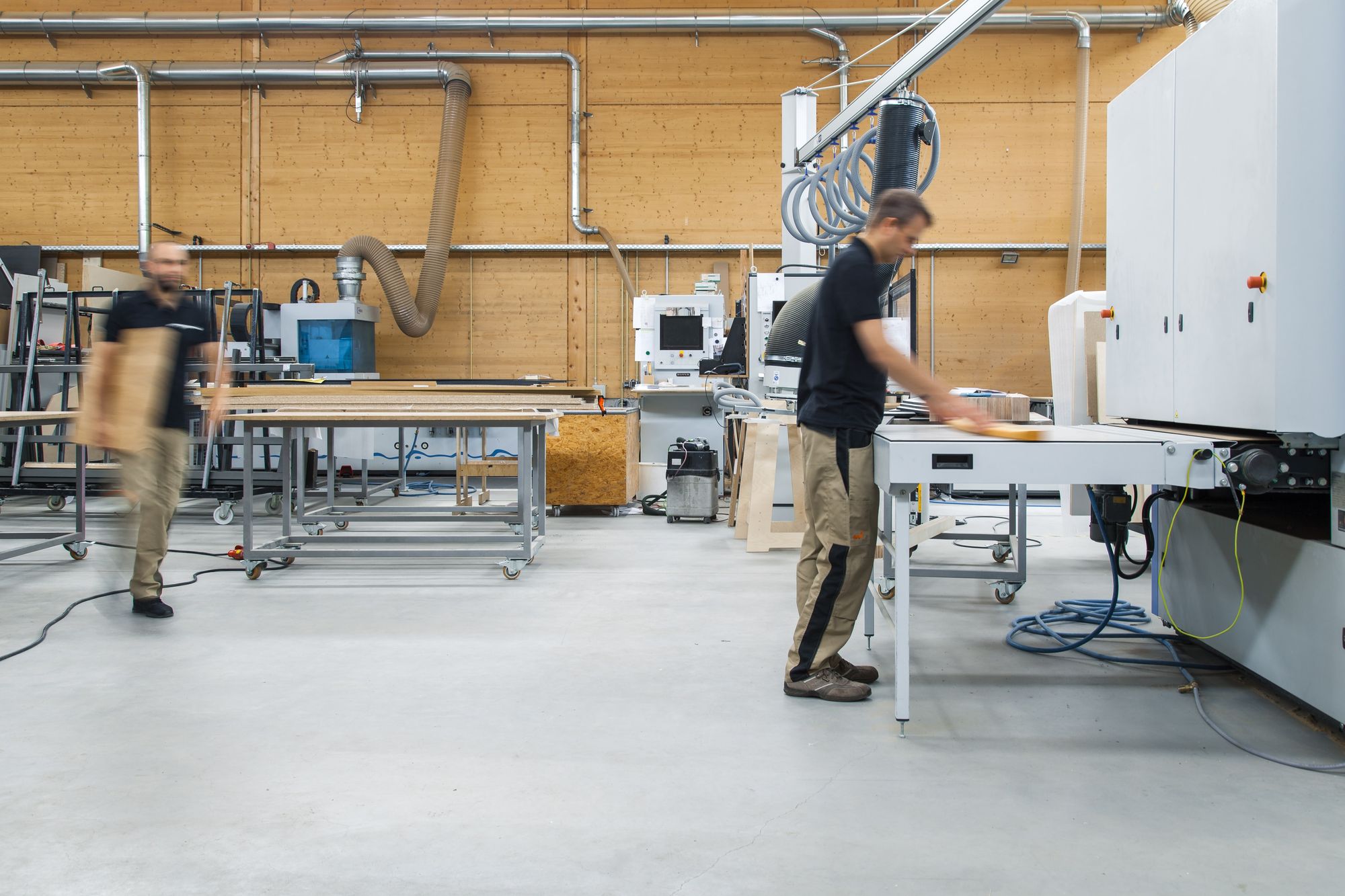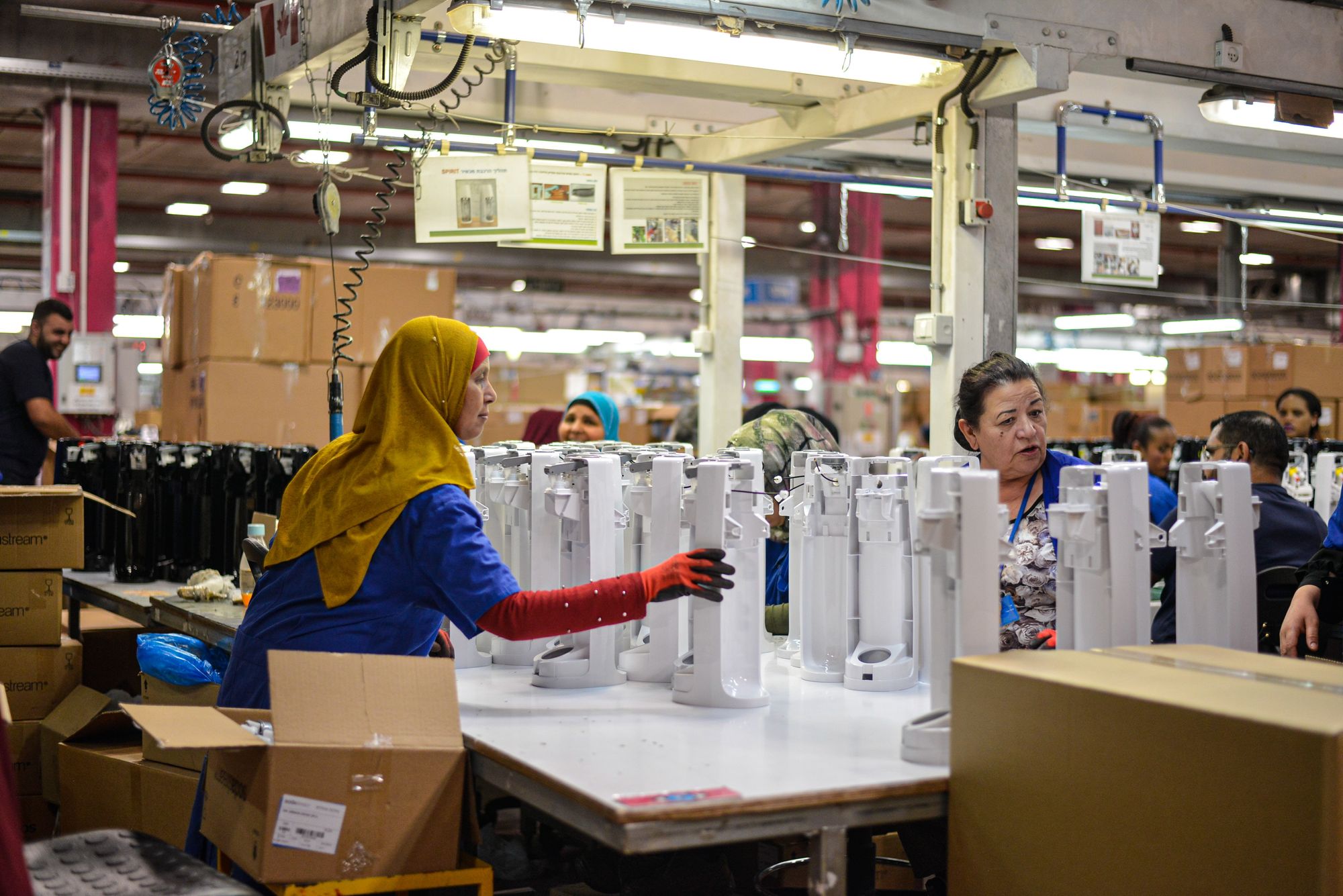Are you a business owner who is considering IoT implementation to ensure safer workplaces? Are you looking to have a deeper understanding of how IoT implementation has led to safer workplaces and how to implement it?
If your answer to these questions is yes, then this article is for you.

First, let us see some of the recent statistics that will help you analyze whether IoT implementation does lead to safer workplaces or not.
- IoT devices have helped reduce workplace accidents by 50% in the construction industry (Source: "Smart Construction: The Future of Workplace Safety," Forbes, 2020)
- IoT-enabled wearable devices have reduced workplace injuries by 35% in the manufacturing sector (Source: "IoT in Manufacturing: Improving Safety in the Workplace," IoT for All, 2021)
- Real-time monitoring of hazardous work environments using IoT has resulted in a 25% decrease in workplace injuries in the oil and gas industry (Source: "The Impact of IoT on Workplace Safety in the Oil and Gas Industry," IoT Evolution, 2020)
- Smart safety systems utilizing IoT have led to a 40% reduction in workplace accidents in the transportation sector (Source: "IoT and Workplace Safety: Reducing Accidents in Transportation," IoT Analytics, 2021)
- IoT-powered predictive maintenance has reduced workplace accidents by 30% in the utility industry (Source: "IoT and Predictive Maintenance: Improving Workplace Safety in the Utilities Industry," IoT News, 2020)
Thus, as is evident, IoT implementation does lead to significantly safer workplaces. In fact, this is by such huge percentages that its implementation has become unavoidable if you want to remain competitive, implement sustainability, and be relevant in these dynamic times.
IoT in workplace safety refers to the use of Internet of Things (IoT) technology to monitor and manage safety and health conditions in the workplace.
This can include monitoring the environment for air quality, temperature, humidity, and sound levels, as well as tracking employee activity and movement.
This can help employers identify risks and hazards before they become a problem and take proactive steps to improve workplace safety.
However, in order for you to implement it in your workplace, let us first have a complete understanding of it.
This article will hence cover the following topics:
- What is IoT (or the Internet of Things)?
- What is IoT in Workplace Safety?
- What are the 11 Ways in Which IoT is Leading to Safer Workplaces?
- What are the Advantages of a Business Ensuring Safer Workplaces?
- How to Implement IoT in Workplaces to Make them Safer?
- FAQs Related to IoTs Leading to Safer Workplaces
- How can Deskera Help You with IoT Implementation?
- Key Takeaways
- Related Articles
What is IoT (or the Internet of Things)?
IoT stands for Internet of Things. It refers to the interconnected network of physical devices, vehicles, home appliances, and other items embedded with electronics, software, sensors, and connectivity which enables these objects to collect and exchange data.
The IoT concept enables objects to be sensed and controlled remotely across existing network infrastructure, creating opportunities for more direct integration between the physical world and computer-based systems, resulting in improved efficiency, accuracy, and economic benefit.
What is IoT in Workplace Safety?
IoT (Internet of Things) in workplace safety refers to the use of connected devices and sensors in the workplace to monitor conditions and gather data in real-time to improve safety and prevent accidents.
This technology can range from wearable devices for workers to track movements and alert them of potential hazards, to smart systems for monitoring environmental conditions such as temperature, humidity, and air quality, to predictive maintenance systems that can detect equipment malfunctions before they lead to accidents.
The aim of IoT in workplace safety is to provide real-time data, identify potential risks, and make it possible to take proactive measures to prevent accidents and improve overall safety in the workplace.
What are the 11 Ways in Which IoT is Leading to Safer Workplaces?
The Internet of Things (IoT) has the potential to make workplaces safer by providing real-time monitoring, predictive maintenance, safety alerts, remote access control, location tracking, inventory management, wearable devices, vehicle tracking, process automation, safety data analysis, and data collection.
Here are a few ways in which IoT is helping to enhance workplace safety:
Real-Time Monitoring
IoT devices can be used to monitor various workplace conditions, such as temperature, air quality, and other environmental factors. This allows workers to be alerted to hazardous conditions in real time, preventing accidents and health problems.
For instance, there are wearable communication systems that allow operators to receive personal safety and time-critical updates by providing alerts within their peripheral vision regarding out-of-tolerance conditions.
In fact, IoT systems can also help you and your employees in preventing unplanned gas releases by quickly responding to temperature changes or variances in gas levels. It does this by sending automated alerts whenever such problems occur.
All of this leads to the retention of top talents, as well as better management of workplace stress.
Predictive Maintenance
IoT devices can be used to monitor equipment and machinery for signs of wear and tear, allowing maintenance to be performed before a failure occurs. For example, a slow gas leak or overheating equipment can be detected with IoT devices and repaired before the problem goes out of hand.
This helps prevent accidents and downtime. It will also ensure that your customers are satisfied, which leads to improved customer retention and customer loyalty. This also leads to higher revenues and net profit ratio of your business.
Safety Alerts
IoT devices can be programmed to send alerts when safety thresholds are breached. For example, if a temperature exceeds a safe limit, an alert can be sent to notify workers and management.
This will help improve your operational metrics, keep your employees safe, and have a positive brand image. It also helps in controlling your operating costs, which would have increased if the problem had been detected later.
Additionally, it will also help ensure that your workers are following the safety rules and regulations as required by the regulatory authorities. This will prevent your organization from being penalized for the same.
Remote Access Control
IoT devices can be used to control access to hazardous areas, ensuring that only authorized personnel have access. This helps prevent accidents caused by unauthorized access.
In fact, the ability to remote-monitor containers and other equipment can protect workers by keeping them from doing personal inspections in dangerous environments.
Remote access control will also help in monitoring whether the shop floor schedule, as well as the master production schedule, is being followed accurately or not. It will also help in monitoring the overtime worked by the employees, as well as their productivity.
Location Tracking
IoT devices can be used to track the location of workers, especially in hazardous or remote environments. This can help ensure their safety and provide rapid response in case of an emergency. Location tracking will also help ensure that the workers are adhering to their roles and responsibilities from the production planning and scheduling.
Speed of Rescue Operations
Critical IoT data is instantly accessible in real-time in the event of a plant accident or major injury to aid medical workers or rescue crews in swiftly understanding the situation and making decisions regarding the implementation of the best possible response plan. When a chemical leak or explosion occurs, for instance, GPS devices can quickly locate trapped or injured workers as well as the best evacuation routes.
Inventory Management
IoT devices can be used to monitor the inventory of safety equipment and supplies, ensuring that workers have access to the necessary equipment at all times. With IoT devices, inventory management becomes not only simpler but also more efficient, which not only helps in accurately determining the quantity of safety stock but also mitigates the bullwhip effect in supply chains.
Wearable Devices
Wearable devices, such as smartwatches and fitness trackers, can be used to monitor workers' health and alert them to potential health problems. This can help prevent accidents and illnesses caused by fatigue, stress, or other health issues. This will prevent your business from having to cover additional expenses like treatment for workers who have undergone an accident in the workplace.
For instance, hard hats containing sensors can monitor the physical conditions of your workers, like temperature, fatigue, heart rate, oxygen level, and other stresses. This will facilitate you and your team to take timely preventive actions to improve the health and well-being of your workers.
Vehicle Tracking
IoT devices can be used to track and monitor the safety of vehicles and their drivers, especially in hazardous environments. This can help prevent accidents and ensure the safety of drivers and passengers.
In fact, laser scanners can monitor equipment and vehicle navigation in your storage or warehouse areas, which in turn will help in preventing collisions with vehicles while also keeping other workers out of harm's way.
Additionally, these scanners can also make these areas safer by identifying any protruding objects that can become the source of collision or impact. When further combined with radio frequency identification tags (RFID), monitoring of equipment of vehicles will also help you in effectively tracking your inventory and seeing how your employees are interacting with your materials, stock, and equipment.
All of this will also help in ensuring that your workers are adhering to their schedules, have had their maintenance done in a timely manner and that your customers are going to get their demands satisfied on time. This will encourage returning customers, as well as increase sales for your business.
Process Automation
IoT devices can be used to automate processes, reducing the risk of human error and increasing efficiency. This can help prevent accidents caused by human error. Process automation using IoT devices also helps in reducing additional business expenses due to increased efficiency, which in turn leads to a higher ratio of operating income as against operating expenses.
Safety Data Analysis
IoT devices can collect vast amounts of data on workplace conditions, allowing for the analysis of safety trends and the identification of potential hazards. This information can be used to develop strategies to enhance workplace safety and prevent accidents.
What are the Advantages of a Business Ensuring Safer Workplaces?
Ensuring worker safety is not only a legal and ethical responsibility but also a key factor in a business's success. By creating a safe and healthy workplace, businesses can benefit from increased productivity, lower costs, and a better reputation.
Thus, ensuring the safety of workers in a business environment brings several advantages, including:
Improved Employee Morale
A safe workplace can improve employee morale and job satisfaction, leading to increased productivity and loyalty.
Reduced Costs
A safer workplace can reduce costs associated with accidents and injuries, such as medical expenses and worker's compensation claims.
Thus, your net working capital will remain reserved for other tasks like research, continuous innovation, and development, which will lead to long-term profits like better products, sustainable supply chains, and higher gross profits.
Better Reputation
A business with a strong commitment to worker safety can build a positive reputation with workers, customers, partners, and the public. This will lead to positive brand awareness about your business.
Compliance with Regulations
Ensuring worker safety helps businesses stay in compliance with workplace safety regulations, reducing the risk of fines and legal penalties.
Attracting Top Talent
A safe work environment can be a key factor in attracting and retaining top talent, helping businesses remain competitive.
Reduced Accidents
Implementing workplace safety measures reduces the likelihood of accidents and injuries, leading to a safer work environment for employees.
Increased Productivity
A safe workplace promotes better health and reduces the number of lost workdays due to injury, leading to increased productivity.
This will help you stick to your master production schedule, as well as your production planning and scheduling. In fact, your shop floor scheduling will be followed accurately too.
All of this will ensure that your customers are satisfied, thereby encouraging returning customers.
Better Employee Retention
A company that prioritizes employee safety is more likely to retain its employees, reducing turnover and the cost of hiring and training new workers.
Lower Insurance Costs
A safe workplace reduces the likelihood of accidents and injury claims, leading to lower insurance costs. Thus, the cash flow of your business will be improved.
Increased Employee Trust
When employees trust that their employer is committed to their safety, they are more likely to have a positive attitude and be committed to their work.
Improved Risk Management
Implementing safety measures helps companies identify and mitigate potential risks, reducing their exposure to liability.
Better Business Performance
A safe workplace promotes better health and reduces the number of lost workdays due to injury, leading to improved business performance and increased profitability. This will lead to improved operational metrics, business metrics, and financial KPIs of your business.
How to Implement IoT in Workplaces to Make them Safer?
By following these steps, your business can effectively implement IoT technology in the workplace to create a safer and more efficient work environment.
Identify Safety Needs
The first step is to identify specific safety needs in the workplace. This can be done by conducting a risk assessment and evaluating areas that can benefit from IoT technology.
Choose IoT Devices
Based on the identified safety needs, choose the appropriate IoT devices and sensors, such as wearable devices, smart cameras, or environmental sensors.
Install and Connect Devices
Install the chosen IoT devices and sensors in the workplace, and connect them to the IoT network. This can be done through Wi-Fi, Bluetooth, or other wireless protocols.
Establish Data Collection and Management
Establish a system for collecting and analyzing data from IoT devices and sensors. This can include cloud-based platforms, databases, and analytics tools.
Monitor and Respond to Data
Monitor the data collected from the IoT devices and sensors, and respond promptly to any potential safety hazards. This can include sending alerts, triggering alarms, or triggering automated responses. To prevent data leakage or data misuse, you may even want to put a DLP solution in place as well. Proofpoint is one example, although there are other DLP solution alternatives, with similar features as well.
Continuously Evaluate and Improve
Continuously evaluate and improve the IoT safety system by collecting feedback from employees, analyzing performance data, and updating the system as needed.
Train Employees
Ensure that employees are trained on the use of IoT devices and how to respond to any potential safety hazards.
FAQs Related to IoTs Leading to Safer Workplaces
- What is IoT, and how does it relate to workplace safety?
IoT stands for Internet of Things and refers to the interconnected network of physical devices that collect and exchange data. In the context of workplace safety, IoT devices and sensors can be used to monitor and respond to potential safety hazards in real time.
- What are some examples of IoT devices used for workplace safety?
Examples of IoT devices used for workplace safety include wearable devices, smart cameras, environmental sensors, and equipment monitoring devices.
- How does IoT help to improve workplace safety?
IoT helps to improve workplace safety by providing real-time monitoring and alerts, predictive maintenance, employee tracking, improved compliance, and increased efficiency.
- Can IoT devices be used to track employee location and safety?
Yes, IoT devices can be used to track the location and safety of employees, especially in hazardous work environments.
- How does IoT help to ensure compliance with safety regulations?
IoT systems can automatically record and store data related to workplace safety, helping businesses stay compliant with safety regulations and minimize risk.
- Can IoT devices be used to predict equipment failures?
Yes, IoT devices can track and analyze data on equipment usage and performance, enabling predictive maintenance and reducing the risk of equipment failure.
- How does IoT help to reduce the risk of accidents and injuries in the workplace?
IoT devices provide real-time monitoring and alerts, allowing for early detection and response to potential safety hazards, reducing the risk of accidents and injuries in the workplace.
- Can IoT devices be used to monitor environmental conditions in the workplace?
Yes, IoT devices such as environmental sensors can be used to monitor environmental conditions in the workplace, such as temperature, humidity, and air quality.
- How does IoT help to increase efficiency in the workplace?
By automating safety processes and reducing the need for manual checks, IoT can help increase efficiency and productivity in the workplace.
- Can IoT devices be integrated with existing systems in the workplace?
Yes, IoT devices can be integrated with existing systems in the workplace, such as building management systems, security systems, and equipment monitoring systems.
- How does IoT help to enhance employee morale in the workplace?
When employees feel safe in their work environment, they are more likely to be engaged, motivated, and productive, leading to enhanced employee morale.
- Can IoT devices be used to track employee health and well-being?
Yes, IoT devices, such as wearable devices, can be used to track employee health and well-being, such as heart rate, stress levels, and sleep patterns.
- How does IoT help to reduce insurance costs for businesses?
A safe workplace reduces the likelihood of accidents and injury claims, leading to lower insurance costs for businesses.
- Can IoT devices be used to improve risk management in the workplace?
Yes, IoT devices can help companies identify and mitigate potential risks, reducing their exposure to liability and improving risk management in the workplace.
- How can businesses ensure the security and privacy of data collected by IoT devices?
Businesses can ensure the security and privacy of data collected by IoT devices by implementing secure data storage and transfer protocols, using encryption, and regularly updating security software and systems.
How can Deskera Help You with IoT Implementation?
Deskera is a cloud-based software company that offers a suite of business management solutions, including an IoT platform. The Deskera IoT platform can help businesses with IoT implementation in several ways:
- Connecting devices: Deskera IoT platform allows businesses to connect and manage their IoT devices, collecting and analyzing data from them in real time.
- Integration with other systems: Deskera IoT platform can integrate with other systems, such as ERP, MRP and CRM, providing a single view of the data and enabling businesses to make informed decisions.
- Predictive maintenance: Deskera IoT platform can analyze the data collected from IoT devices and provide insights and alerts for predictive maintenance, reducing downtime and increasing efficiency.
- Remote monitoring: The Deskera IoT platform allows businesses to monitor their IoT devices remotely, reducing the need for manual inspections and increasing the speed of response to any issues.
- Customizable dashboards: Deskera IoT platform provides customizable dashboards, allowing businesses to view their data in the way that works best for them.
- Scalability: Deskera IoT platform is scalable, making it suitable for businesses of all sizes, from small businesses to large enterprises.
Key Takeaways
IoT in workplace safety refers to the use of Internet of Things (IoT) technology to monitor and manage safety and health conditions in the workplace.
This can include monitoring the environment for air quality, temperature, humidity, and sound levels, as well as tracking employee activity and movement. This can help employers identify risks and hazards before they become a problem and take proactive steps to improve workplace safety.
Employees are safest in those work settings where the management is fully committed to the safety of its workers and is even willing to invest in the technology and training that is needed to maximize worker safety.
The eleven ways in which IoT is leading to safer workplaces are:
- Real-Time Monitoring
- Predictive Maintenance
- Safety Alerts
- Remote Access Control
- Location Tracking
- Speed of Rescue Operations
- Inventory Management
- Wearable Devices
- Vehicle Tracking
- Process Automation
- Safety Data Analysis
As is evident from the recent trends, IoT (or the Internet of Things) is crucial for creating a culture of ongoing worker safety. This will boost profitability for your business by improving worker morale, productivity, and retention.
In fact, having a reputation for taking care of its workers will also become an effective corporate recruiting tool for your business. This is especially true today when qualified workers are in such high demand and are especially selective with their employees.
The steps to implementing IoT in workplaces to make them safer are:
- Identify Safety Needs
- Choose IoT Devices
- Install and Connect Devices
- Establish Data Collection and Management
- Monitor and Respond to Data
- Continuously Evaluate and Improve
- Train Employees
Deskera can help your business with IoT implementation by providing a platform to connect and manage their devices, integrating with other systems, providing insights and alerts, and enabling remote monitoring and custom dashboards.
Related Articles














